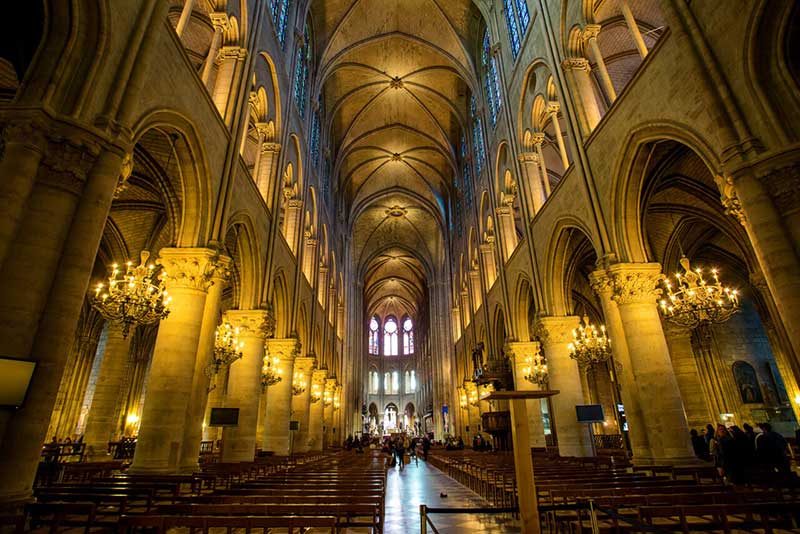 The Cathedral Notre Dame de Paris stands as an iconic symbol of French Gothic architecture, a masterpiece that has captivated millions of visitors from around the world. With its majestic towers, intricate sculptures, and breathtaking stained glass windows, the cathedral has witnessed centuries of history and played a significant role in shaping the cultural fabric of Paris. In this article, iqnect will embark on a journey to unravel the fascinating history of the Cathedral Notre Dame de Paris.
The Cathedral Notre Dame de Paris stands as an iconic symbol of French Gothic architecture, a masterpiece that has captivated millions of visitors from around the world. With its majestic towers, intricate sculptures, and breathtaking stained glass windows, the cathedral has witnessed centuries of history and played a significant role in shaping the cultural fabric of Paris. In this article, iqnect will embark on a journey to unravel the fascinating history of the Cathedral Notre Dame de Paris.
Introduction
The Cathedral Notre Dame de Paris, often simply referred to as Notre Dame, is situated on the Île de la Cité, a small island in the heart of Paris. Its construction began in 1163 and was completed nearly 200 years later. The cathedral’s architectural grandeur and historical significance make it an essential landmark in France.The Construction of Notre Dame de Paris
Notre Dame de Paris was commissioned by Maurice de Sully, the bishop of Paris, who envisioned a grand cathedral that would surpass all others in beauty and magnificence. Construction began in 1163, with the choir being the first section to take shape. Skilled artisans and craftsmen dedicated their lives to bring the bishop’s vision to life.Architectural Features and Design
The cathedral’s architecture is a testament to the mastery of French Gothic style. It features pointed arches, ribbed vaults, and flying buttresses, all designed to create a sense of verticality and awe. The façade of Notre Dame is adorned with intricate sculptures, showcasing biblical scenes and saints. The stunning rose windows, particularly the North Rose Window, are a marvel of medieval stained glass craftsmanship.The Role of Notre Dame in French History
Throughout its existence, Notre Dame de Paris has witnessed numerous significant events in French history. It was the site of Napoleon Bonaparte’s coronation as Emperor of the French in 1804 and the venue for the beatification of Joan of Arc in 1909. The cathedral also played a crucial role during the French Revolution when it was converted into a Temple of Reason.
Notable Events and Restorations
Over the centuries, Notre Dame de Paris has faced its fair share of challenges. It underwent various modifications and restorations, including the addition of the iconic spire by Eugène Viollet-le-Duc in the 19th century. However, one of the most significant challenges came in April 2019 when a devastating fire engulfed the cathedral, causing extensive damage to its roof and spire.The Hunchback of Notre Dame
No exploration of Notre Dame’s history would be complete without mentioning Victor Hugo’s famous novel, “The Hunchback of Notre Dame.” Published in 1831, the novel brought renewed attention to the cathedral and its significance, immortalizing it in literature and popular culture.Notre Dame in Popular Culture
The Cathedral Notre Dame de Paris has served as a backdrop for various works of art, literature, and film. Its awe-inspiring beauty and historical aura have inspired countless artists, writers, and filmmakers to capture its essence. From paintings by Claude Monet to Disney’s animated adaptation of “The Hunchback of Notre Dame,” the cathedral’s influence on popular culture is undeniable.The Devastating Fire of 2019
On April 15, 2019, a fire broke out in the attic of Notre Dame de Paris, engulfing the roof and toppling the iconic spire. The world watched in shock and disbelief as the flames threatened to consume centuries of history and cultural heritage.The Ultimate Guide to Staying in a Japanese Ryokan
The Restoration Efforts
In the wake of the fire, an outpouring of support and solidarity emerged from around the globe. Pledges of financial assistance poured in, and skilled craftsmen and experts came together to devise a plan for the cathedral’s restoration. The restoration efforts aim to preserve the historical integrity of Notre Dame while incorporating modern techniques and materials.Conclusion
The Cathedral Notre Dame de Paris stands as a testament to human creativity, resilience, and the enduring spirit of a city. Its rich history, architectural splendor, and cultural significance have made it a cherished symbol of Paris and a UNESCO World Heritage Site. As the restoration work progresses, Notre Dame will continue to inspire awe and captivate the hearts of visitors for generations to come.Is There a Connection Between Steeplechase Park and Notre Dame Cathedral?
Unveiling the intriguing history of steeplechase park reveals a lack of direct connection with Notre Dame Cathedral. Steeplechase Park, a notable amusement park in Coney Island, New York, operated from 1897 to 1964, while the iconic Notre Dame Cathedral is located in Paris, France, dating back to the 12th century. Despite their distinct histories, both landmarks hold their own significance in shaping culture and attracting visitors from around the world.
